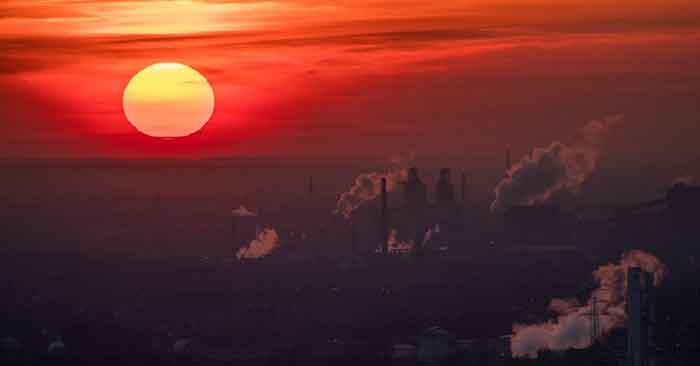
A new study projecting the amount of heat stress residents of the South Asia region will experience in the future finds with 2 degrees Celsius of warming, the population’s exposure to heat stress will nearly triple.
Limiting warming to 1.5 degrees Celsius will likely reduce that impact by half, but deadly heat stress will become commonplace across South Asia, according to the new study (Fahad Saeed, Carl‐Friedrich Schleussner, Moetasim Ashfaq, Deadly heat stress to become commonplace across South Asia already at 1.5°C of global warming, Geophysical Research Letters, 2021; DOI: 10.1029/2020GL091191) in Geophysical Research Letters, American Geophysical Union’s journal publishing high-impact, short-format reports with immediate implications spanning all Earth and space sciences.
With almost one quarter of the world’s population living in South Asia, the new study underlines the urgency of addressing climate change.
Earth has warmed by 1 degree Celsius since the start of the Industrial Revolution, according to the Intergovernmental Panel on Climate Change. On the current climate trajectory, it may reach 1.5 degrees Celsius of warming in 2040. This deadline leaves little time for South Asian countries to adapt.
People living in South Asia are especially vulnerable to deadly heat waves because the area already experiences very hot, humid summers. Much of the population live in densely populated cities without regular access to air conditioning, and about 60% perform agricultural work and cannot escape the heat by staying indoors.
In the new study, the researchers used climate simulations and projections of future population growth to estimate the number of people who will experience dangerous levels of heat stress in South Asia at warming levels of 1.5 and 2 degrees Celsius. They estimated the wet bulb temperature residents will experience, which is similar to the heat index, as it takes into account humidity as well as temperature. A wet bulb temperature of 32 degrees Celsius (89.6 degrees Fahrenheit) is considered to be the point when labor becomes unsafe, and 35 degrees Celsius (95 degrees Fahrenheit) is the limit to human survivability, when the body can no longer cool itself.
Their analysis suggests at 2 degrees of warming, the population’s exposure to unsafe labor temperatures will rise more than two-fold, and exposure to lethal temperatures rises 2.7 times, as compared to recent years.
Curbing warming to 1.5 degrees Celsius will likely cut that exposure in half, but large numbers of people across South Asia will still experience extreme temperatures. An increase in heat events that create unsafe labor conditions are likely to occur in major crop producing regions in India, such as West Bengal and Uttar Pradesh, and in Pakistan in Punjab and Sindh. Coastal regions and urban centers such as Karachi, Kolkata, Mumbai, Hyderabad and Peshawar are also likely to be heavily affected, according to the study.
The results differ from a similar study conducted in 2017, which predicted that heat waves of lethal temperatures will occur in South Asia toward the end of the 21st century. The researchers suspect the earlier study is too conservative, as deadly heat waves have already hit the region in the past. In 2015, large parts of Pakistan and India experienced the fifth deadliest heat wave in the recorded history, which caused about 3,500 heat-related deaths.
“A policy framework is very much needed to fight against heat stress and heat wave-related problems,” said T.V. Lakshmi Kumar, an atmospheric scientist at India’s SRM Institute of Science and Technology who was not involved in the work. “India has already committed to reduce emissions to combat climate change issues.”
Heat extremes will lead to climate-induced waves of migration toward the cooler north
The study (George Zittis, Panos Hadjinicolaou, Mansour Almazroui, Edoardo Bucchignani, Fatima Driouech, Khalid El Rhaz, Levent Kurnaz, Grigory Nikulin, Athanasios Ntoumos, Tugba Ozturk, Yiannis Proestos, Georgiy Stenchikov, Rashyd Zaaboul, Jos Lelieveld, Business-as-usual will lead to super and ultra-extreme heatwaves in the Middle East and North Africa, npj Climate and Atmospheric Science, 2021; 4 (1) DOI: 10.1038/s41612-021-00178-7), building on cooperation between climate scientists from the MENA region, aimed at assessing emerging heatwave characteristics. The research team used a first-of-its-kind multi-model ensemble of climate projections designed exclusively for the geographic area. Such detailed downscaling studies had been lacking for this region.
The researchers then projected future hot spells and characterized them with the Heat Wave Magnitude Index. The good match among the model results and with observations indicates a high level of confidence in the heat wave projections.
“Our results for a business-as-usual pathway indicate that especially in the second half of this century unprecedented super- and ultra-extreme heatwaves will emerge,” explains George Zittis of The Cyprus Institute, first author of the study. These events will involve excessively high temperatures of up to 56 degrees Celsius and higher in urban settings and could last for multiple weeks, being potentially life-threatening for humans and animals. In the second half of the century, about half of the MENA population or approximately 600 million people could be exposed to such annually recurring extreme weather conditions.
“Vulnerable citizens may not have the means to adapt to such harsh environmental conditions,” adds Jos Lelieveld, Director at the Max Planck Institute for Chemistry and leading the research team. “These heat waves combined with regional economic, political, social and demographic drivers have a high potential to cause massive, forced migration to cooler regions in the north.”
To avoid such extreme heat events in the region, the scientists recommend immediate and effective climate change mitigation measures. “Such measures include drastic decreases of the emissions of greenhouse gases such as carbon dioxide and methane into the atmosphere, but also adaptation solutions for the cities in the area,” says Lelieveld. It is expected that in the next 50 years, almost 90 percent of the exposed population in the MENA will live in urban centers, which will need to cope with these societally disruptive weather conditions. “There is an urgent need to make the cities more resilient to climate change,” emphasizes Zittis.
GET COUNTERCURRENTS DAILY NEWSLETTER STRAIGHT TO YOUR INBOX













































